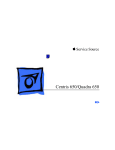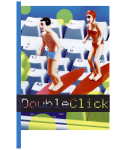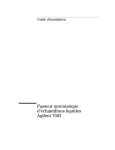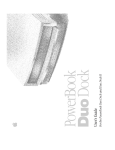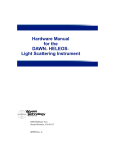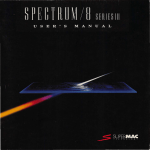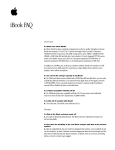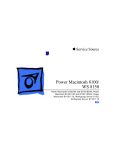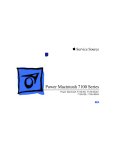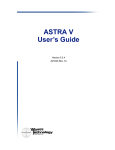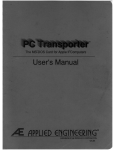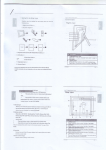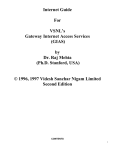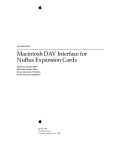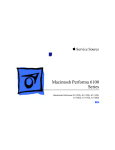Download Macintosh Performa 600 series Specifications
Transcript
K Service Source Macintosh IIvx, IIvi, Performa 600 Macintosh IIvx, Macintosh IIvi, Performa 600 K Service Source Basics Macintosh IIvx, Macintosh IIvi, Performa 600 Basics Overview - 1 Overview This manual includes complete repair procedures for the Macintosh IIvx, Macintosh IIvi, and Performa 600. Figure: Macintosh IIvx, IIvi, and Performa 600 K Service Source Specifications Macintosh IIvx, Macintosh IIvi, Performa 600 Specifications Processors - 1 Processors CPU Motorola 68030 microprocessor Built-in memory management unit (MMU) Macintosh IIvi: 16 MHz Macintosh IIvx, Performa 600: 32 MHz Coprocessor Macintosh IIvx: Motorola 68882 floating-point unit (FPU) Cache Macintosh IIvx: 32K Addressing 32-bit internal registers 32-bit address bus 32-bit data bus Specifications Memory - 2 Memory RAM 4, 5, or 8 MB, expandable to 68 MB ROM 1 MB PRAM 256 bytes of parameter memory VRAM With 512K VRAM, these video modes are supported: With 1 MB VRAM, these video modes are supported: 512K or 1 MB, upgradable to 1 MB • 512 by 384 pixel screens with 2, 4, 8, and 16 bits per pixel • 640 by 480 pixel screens with 2, 4, and 8 bits per pixel • 512 by 384 pixel screens with 2, 4, 8, and 16 bits per pixel • 640 by 480 pixel screens with 2, 4, 8, and 16 bits per pixel Specifications Disk Storage - 3 Disk Storage Floppy Drive 1.4 MB floppy drive Hard Drive 80–400 MB hard drive CD-ROM Drive Optional CD-ROM drive Specifications 1/O Interfaces - 4 1/O Interfaces Expansion Three NuBus slots One accelerator slot SCSI One SCSI port; DB-25 connector Supports a maximum of six external devices Apple Desktop Bus Two Apple Desktop Bus (ADB) ports Low-speed synchronous serial interface Serial Two RS-232/RS-422 serial ports; mini DIN-8 connectors 230.4 Kbaud maximum 0.92 Mbit/sec., if external clock source is provided Specifications 1/O Interfaces - 5 Sound One sound output port for stereo playback from CDs Monaural input port Video One video port DB-15 connector Supports Apple monitors (8-bit) Specifications I/O Devices - 6 I/O Devices Keyboard Mouse Microphone Standard or Extended Keyboard connected through Apple Desktop Bus (ADB) ports (mini DIN-4) Maximum power draw for all ADB devices: 500 mA Keyboard draws 25–80 mA ADB mouse Draws up to 80 mA Electret, omnidirectional microphone Microphone output voltage is 4 mV peak to peak at normal speaking volume Specifications Sound and Video - 7 Sound and Video Apple Monitor Macintosh IIvi/vx and Performa 600 video support includes these Apple monitors: • Apple Color Display • Macintosh 12-in. Monochrome Display • Macintosh 12-in. RGB Display • AppleColor High-Resolution RGB Monitor • Apple Performa Display/Plus Third-Party Monitors Nubus video cards allow the computer to support other non-Apple VGA, NCST, and PAL monitors Sound Custom Sound Chip drives stereo miniature headphone jack Specifications Electrical - 8 Electrical A/C Line Input Line voltage: 100–120 VAC Power: 200 W A/C Line Output Output receptacle: 100–240 VAC 3 A maximum DC Power 112 W maximum Specifications Physical - 9 Physical Temperature Operating: 10–40° C (50–104 ° F) Storage -40 to 47° C (-40 F to 116.6° F) Relative Humidity 5–95% noncondensing Altitude Zero to 10,000 ft. (3,048 m) K Service Source Troubleshooting Macintosh IIvx, Macintosh IIvi, Performa 600 Troubleshooting General/ - 1 General The Symptom Charts included in this chapter will help you diagnose specific symptoms related to your product. Because cures are listed on the charts in the order of most likely solution, try the first cure first. Verify whether or not the product continues to exhibit the symptom. If the symptom persists, try the next cure. (Note: If you have replaced a module, reinstall the original module before you proceed to the next cure.) If you are not sure what the problem is, or if the Symptom Charts do not resolve the problem, refer to the Flowchart for the product family. For additional assistance, contact Apple Technical Support. Troubleshooting Symptom Charts/Video - 2 Symptom Charts Video Screen is dark, audio and at least one drive operate, fan is running, and LED is lit 1 2 3 4 5 Adjust brightness on monitor. Replace monitor. Refer to appropriate monitor manual to troubleshoot defective monitor. Replace video cable. Replace VRAM SIMMs. Replace logic board. Retain customer’s SIMMs. Screen is dark, audio and drive do not operate, fan is running, and LED is lit 1 2 3 4 5 6 Remove peripherals. Remove NuBus cards. Replace DRAM SIMMs. Replace VRAM SIMMs. Replace power supply. Replace logic board. Troubleshooting Symptom Charts/Video (Continued) - 3 Video (Continued) Partial or whole screen is bright and audio is present, but no video information is visible 1 Screen is completely dark, fan is not running, and LED is not lit 1 2 3 2 3 4 4 5 6 Replace monitor. Refer to appropriate monitor manual to troubleshoot defective monitor. Replace video cable. Replace VRAM SIMMs. Replace logic board. Retain customer’s SIMMs. Verify that external power cables are properly connected. Remove peripherals. Remove NuBus cards and switch on power again. (Combined NuBus cards should not draw more than 45 watts.) Remove accelerator card. Replace power supply. Replace logic board. Retain customer’s SIMMs. Troubleshooting Symptom Charts/Floppy Drive - 4 Floppy Drive Audio and video are present, but internal floppy drive does not operate 1 2 3 Replace internal floppy drive cable. Replace internal floppy drive. Replace logic board. Retain customer’s SIMMs. Floppy disk ejects, and display shows Mac icon with blinking “X” 1 2 3 4 Replace floppy disk. Replace floppy drive cable. Replace internal floppy drive. Replace logic board. Retain customer’s SIMMs. Floppy disk does not eject 1 Switch off system and hold mouse button down while switching system on. Eject disk manually. Replace floppy drive cable. Replace floppy drive. 2 3 4 Troubleshooting Symptom Charts/Floppy Drive (Continued) - 5 Floppy Drive (Continued) Floppy drive attempts to eject disk but doesn’t 1 2 3 Push floppy disk completely in. Eject floppy disk manually by pushing opened paper clip into hole beside drive slot. Replace floppy drive. Troubleshooting Symptom Charts/Hard Drive - 6 Hard Drive Internal hard drive runs continuously Internal hard drive does not operate 1 2 3 4 Turn off virtual memory if it’s on and check to see if hard drive stops running. Hard drive runs more with virtual memory on. Replace SCSI data cable. Replace internal hard drive. Replace logic board. Retain customer’s SIMMs. 1 2 3 4 Replace SCSI data cable. Replace SCSI power cable. Replace hard drive. Replace logic board. Retain customer’s SIMMs. Troubleshooting Symptom Charts/CD-ROM Drive - 7 CD-ROM Drive CD-ROM drive does not accept a compact disc 1 2 Exchange disc (if disc is dirty or damaged). Replace CD-ROM drive mechanism. Macintosh does not display CD-ROM drive icon 1 Reinstall CD software, and verify that CD-ROM extensions are in System Folder. Reinstall system software. Replace CD-ROM drive mechanism. Replace power supply. Replace SCSI data cable. 2 3 4 5 Troubleshooting Symptom Charts/Peripherals - 8 Peripherals Works with internal or external SCSI device, but does not work with both 1 Cursor does not move 1 2 3 2 3 4 4 5 Verify that SCSI select switch on any external device is set differently from any internal SCSI device. Verify that hard drive is terminated but optional CD-ROM is not terminated. Replace terminator on external SCSI device. Replace SCSI select cable on external SCSI device. Reboot computer. Verify that mouse is connected properly. If mouse was connected to keyboard, connect mouse to computer ADB port instead. If mouse works, replace keyboard. If mouse does not work in any ADB port on computer, replace mouse. Replace logic board. Retain customer’s SIMMs. Troubleshooting Symptom Charts/Peripherals (Continued) - 9 Peripherals (Continued) Cursor moves, but clicking the mouse button has no effect 1 2 Replace mouse. Replace logic board. Retain customer’s SIMMs. Double-click does not open application, disk, or server 1 2 Remove duplicate system files from hard drive. Clear parameter RAM. Hold down <Command> <Option> <P> <R> during startup but before “Welcome to Macintosh” appears. If mouse was connected to keyboard, connect mouse to computer ADB port instead. If mouse works, replace keyboard. If mouse does not work in any ADB port on computer, replace mouse. Replace logic board. Retain customer’s SIMMs. 3 4 5 Troubleshooting Symptom Charts/Peripherals (Continued) - 10 Peripherals (Continued) No response to any key on the keyboard 1 2 3 4 Verify that keyboard is connected to ADB port. Replace keyboard cable. Replace keyboard. Replace logic board. Retain customer’s SIMMs. Beeping sound when any key is pressed. Turn off Slow Keys from the Easy Access control panel. K Service Source Take Apart Macintosh IIvx, Macintosh IIvi, Performa 600 Take Apart Top Cover - 1 Top Cover Top Cover No preliminary steps are required before you begin this procedure. 1 2 Captive Screw Loosen the captive screw. Slide the top cover toward the front of the computer about 1 inch and lift off the cover. Replacement Note: Do not jar the reset/interrupt switch and light pipe out of alignment when you replace the top cover. Take Apart Power Supply - 2 Power Supply Power Supply Before you begin, remove the cover. Caution: Review the ESD precautions in Bulletins/ Safety. Take Apart Power Supply - 3 1 CD-ROM Drive If a CD-ROM drive is installed, squeeze its side tabs and pull the drive out an inch or two to more easily reach the power supply. Take Apart Power Supply - 4 2 Screw Rear Bezel Power Supply 3 4 Remove the screw from the rear bezel. Pry the latch away from the base of the power supply. Note: A firm lifting motion is necessary to disconnect the power supply’s connector from the logic board. Grasp the power supply and firmly lift it out of the internal chassis. Latch Take Apart Internal Chassis - 5 Internal Chassis Internal Chassis Before you begin, remove the following: • Cover • Power supply Caution: Review the ESD precautions in Bulletins/ Safety. Take Apart Internal Chassis - 6 1 Floppy Drive Cable SCSI Drive Cable SCSI Power Cable Disconnect these cables: • Floppy drive cable • SCSI power cable • SCSI data cable Take Apart Internal Chassis - 7 2 CD-ROM Drive CD-ROM Audio Cable SCSI Power Cable If a CD-ROM drive is installed, disconnect these cables: • SCSI power cable • SCSI data cable • CD-ROM audio cable Take Apart Internal Chassis - 8 3 Internal Chassis Remove the two screws that secure the internal chassis. Take Apart Internal Chassis - 9 4 Lift the front of the internal chassis until it is perpendicular to the bottom case. Note: The chassis swivels where the chassis tabs meet the bottom cover. Chassis Tabs Take Apart Internal Chassis - 10 5 Internal Chassis (Perpendicular for Removal) Chassis Tab Internal Chassis (Installed) Guide the chassis tabs out of the slots in the bottom case and remove the internal chassis. Take Apart Internal Chassis - 11 Internal Chassis Guides Internal Chassis Replacement Note: Carefully seat the bottom corners of the internal chassis into the guides in the case bottom. Take Apart Floppy Drive - 12 Floppy Drive Floppy Drive Before you begin, remove the cover. Caution: Review the ESD precautions in Bulletins/ Safety. Take Apart Floppy Drive - 13 Floppy Drive 1 2 3 Screw Disconnect the floppy drive cable from the floppy drive. Remove the floppy drive mounting screw. Pry up the mounting tab and slide out the floppy drive. Replacement Note: You may encounter either an autoinject or manual-inject 1.4 MB floppy drive. Replace floppy drives like for like. Tab Floppy Drive Cable Take Apart Hard Drive - 14 Hard Drive Hard Drive Before you begin, remove the cover. Caution: Review the ESD precautions in Bulletins/ Safety. Take Apart Hard Drive - 15 1 Hard Drive 2 3 Screw SCSI Data Cable SCSI Power Cable Disconnect the SCSI data cable and the SCSI power cable from the hard drive. Remove the hard drive mounting screw from the carrier. Lift the back of the hard drive and slide the hard drive carrier out of the internal chassis. Take Apart Hard Drive - 16 Replacement Note: For information on removing the hard drive from the carrier and returning drives, cables, and carriers to Apple, refer to Additional Procedures in the Hard Drives manual. Take Apart CD-ROM Drive - 17 CD-ROM Drive CD-ROM Drive Before you begin, remove the cover. Caution: Review the ESD precautions in Bulletins/ Safety. Note: A CD-ROM Drive is optional. Take Apart CD-ROM Drive - 18 1 CD-ROM Drive Squeeze the side tabs and pull the drive out a few inches to more easily perform the next step. Take Apart CD-ROM Drive - 19 2 CD-ROM Drive Audio Cable SCSI Data Cable SCSI Power Cable Disconnect these cables from the CD-ROM drive: • Audio cable • SCSI power cable • SCSI data cable Take Apart CD-ROM Drive - 20 3 CD-ROM Drive Slide out the CD-ROM drive. Take Apart CD-ROM Drive - 21 Key Replacement Note: The connectors on the SCSI data cable are keyed. You may need to twist the cable to insert the connector properly. Take Apart Speaker - 22 Speaker Speaker Before you begin, remove the cover. Caution: Review the ESD precautions in Bulletins/ Safety. Take Apart Speaker - 23 1 2 Speaker Speaker Cable Logic Board Disconnect the speaker cable from the logic board. Remove the speaker mounting screws and pull out the speaker. Note: Speakers are installed with four or two screws, depending on the version of speaker. Take Apart Logic Board - 24 Logic Board Logic Board Before you begin, remove the following: • Cover • P ower supply • Internal chassis • Reset/Interrupt switch • Speaker Caution: Review the ESD precautions in Bulletins/ Safety. Take Apart Logic Board - 25 1 2 Screw Remove the screw from the center of the logic board. Slide the logic board toward the front of the computer about 1/2 inch and lift the board out of the case. Take Apart Logic Board - 26 Replacement Note: Remove the customer’s SIMMs from the defective logic board and install them on the replacement logic board. Logic Board Replacement Note: Be sure to install the correct logic board. Replacement Note: Position the center rear edge of the logic board into the plastic bracket and slide the board straight back. Logic Board K Service Source Upgrades Macintosh IIvx, Macintosh IIvi, Performa 600 Upgrades Expansion Cards - 1 Expansion Cards Before you begin, remove the cover. Caution: Review the ESD precautions in Bulletins/ Safety. Expansion Card Upgrades Expansion Cards - 2 1 Caution: Pull up evenly on both sides of the card to avoid bending the connector pins. Carefully grasp each end of the card and pull straight up to remove it. Replacement Caution: When replacing the card, do not force it into the expansion slot. If the card does not seat properly, remove it and try again. Upgrades CD-ROM Drive CD-ROM Drive Upgrade - 3 CD-ROM Drive Upgrade Before you begin, remove the cover. Caution: Review the ESD precautions in Bulletins/ Safety. Upgrades CD-ROM Drive Upgrade - 4 1 Blank Bezel Tab From the inside of the top cover, squeeze in the tabs of the blank bezel and push out the bezel. Upgrades CD-ROM Drive Upgrade - 5 2 Slotted Bezel Push in the slotted bezel. Upgrades CD-ROM Drive Upgrade - 6 3 4 CD-ROM Drive Rail CD-ROM Drive CD-ROM Drive Rail Attach the CD-ROM drive rails to the CD-ROM drive. Slide the CD-ROM drive about three quarters of the way into the internal chassis. Upgrades CD-ROM Drive Upgrade - 7 5 CD-ROM Drive CD-ROM Audio Cable SCSI Data Cable SCSI Power Cable Connect these cables to the CD-ROM drive: • CD-ROM audio cable • SCSI data cable • SCSI power cable Upgrades CD-ROM Drive Upgrade - 8 6 CD-ROM Drive Push the CD-ROM drive completely into the CDROM slot until you hear a click. Upgrades IIvx to Macintosh Centris 650 Upgrade - 9 Shielding Gaskets IIvx to Macintosh Centris 650 Upgrade Before you begin, remove the following: • Top cover • Power supply • Internal chassis • Reset/Interrupt switch • Speaker • Logic board Sealing Tape Logic Board Caution: Review the ESD precautions in Bulletins/ Safety. Upgrades IIvx to Macintosh Centris 650 Upgrade - 10 Sealing Tape Note: The Macintosh Centris 650 Upgrade Kit upgrades a Macintosh IIvx to a Macintosh Centris 650. The upgrade kit includes a Macintosh Centris 650 logic board, EMI shielding gaskets, sealing tape, and product name labels. 1 2 Metal Edge Bottom Cover Remove the backing from the sealing tape. Position the sealing tape over the metal edge of the bottom cover. Press firmly and secure the tape to the metal edge and Upgrades IIvx to Macintosh Centris 650 Upgrade - 11 Plastic Bracket 3 Bottom Case 4 Slotted Supports Logic Board 5 the floor of the bottom cover. Position the center rear edge of the logic board in the plastic brackets on the bottom case. Lay the logic board flat. Align the notches in the board with the slotted supports. Slide the board straight back. Upgrades IIvx to Macintosh Centris 650 Upgrade - 12 Shielding Gasket 6 Secure the long strip of the shielding gasket along the bottom edge of the top cover. Upgrades IIvx to Macintosh Centris 650 Upgrade - 13 Floppy Drive Shielding Gasket 7 Secure the smaller shielding gasket on the floppy drive as shown. Upgrades Power Macintosh Upgrade - 14 Power Macintosh Upgrade No preliminary steps are required before you begin this procedure. The Macintosh IIvx, Ilvi, and Performa 600 computers can be upgraded to a Power Macintosh 7100/66 or 7100/66AV. For upgrade instructions, refer to Additional Procedures in the Power Macintosh 7100 manual. K Service Source Additional Procedures Macintosh IIvx, Macintosh IIvi, Performa 600 Additional Procedures Battery Verification - 1 Battery Verification Before you begin, remove the cover. Caution: Review the ESD precautions in Bulletins/ Safety. If handled or discarded improperly, the lithium battery in the computer could explode. Review battery handling and disposal instructions in Bulletins/Safety. ±Warning: Battery Additional Procedures Battery Verification - 2 1 2 Negative Probe Positive Probe 3 Set the voltmeter to the 10 volts DC scale. Hold the positive probe of the voltmeter to the positive end of the battery (marked “+” on the logic board) and the negative probe to the negative end of the battery. If the battery voltage is below 2.8 volts, replace the battery. Refer to “Battery Replacement” in this chapter. Additional Procedures Battery Replacement - 3 Battery Replacement Before you begin, remove the cover. Caution: Review the ESD precautions in Bulletins/ Safety. If handled or discarded improperly, the lithium battery in the computer could explode. Review battery handling and disposal instructions in Bulletins/Safety. ±Warning: Battery Additional Procedures Battery Replacement - 4 1 Using a small flat-blade screwdriver, pry open the latch at the end of the battery holder and lift off the cover. Additional Procedures Battery Replacement - 5 2 3 Grasp the battery and remove it from the holder. Return the battery to Apple for proper disposal. For battery packaging and labeling instructions, refer to the safety information in Bulletins/Safety. Additional Procedures Reset/Interrupt Switch - 6 Reset/Interrupt Switch Before you begin, remove the cover. Caution: Review the ESD precautions in Bulletins/ Safety. Additional Procedures Reset/Interrupt Switch Reset/Interrupt Switch - 7 1 2 With one finger, lift the center tab of the switch. Gently lift the rear of the switch up and away from the front of the case. K Service Source Exploded View Macintosh IIvx, Macintosh IIvi, Performa 600 Exploded View 1 Exploded View Top Cover 922-0056 Hard Drive 661-0182 Power Supply 661-0758 Floppy Drive Cable 922-0112 Floppy Drive 661-0474 661-0121 Hard Drive Data Cable Hard Drive Power Cable 922-0051 CD-ROM Drive 661-1646 (300i) 661-0913 600i) 661-0023 (300) Internal Chassis 922-0058 Logic Board 661-0760 (IIvi) 661-0759 (IIvx) 661-0761 (P600) CD Data Cable 922-0053 Bottom Case 922-0406 Speaker 922-0055












































































